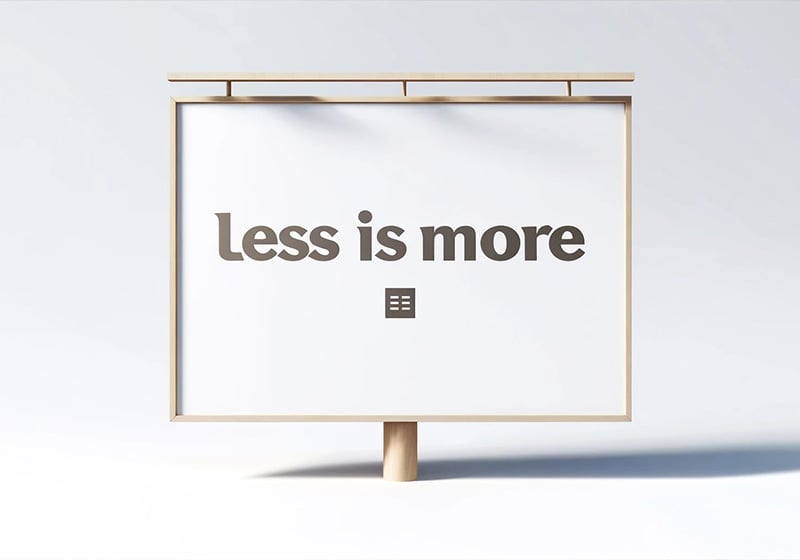Table of Contents
Less is More: Where Does the Quotation Come From?
The phrase “Less is more” is one of the most iconic statements in the world of design and architecture, yet its origins are often misunderstood or overlooked. This powerful aphorism is most commonly attributed to Ludwig Mies van der Rohe, a pioneering architect and a central figure in the modernist movement. Van der Rohe, a German-American architect, was known for his minimalist approach to design, where simplicity and clarity were paramount. His works, including the Barcelona Pavilion and the Seagram Building, are celebrated for their elegance, which is achieved through an economy of means.
Interestingly, Van der Rohe wasn’t the first to utter the phrase. The roots of “Less is more” can be traced back to the poet Robert Browning, who used it in his 1855 poem “Andrea del Sarto”. In the poem, the phrase is used to suggest that something may be more effective or beautiful when it is understated rather than overly complex or ornate. Van der Rohe, however, was the one who adopted this sentiment and applied it to the field of architecture, transforming it into a guiding principle of modern design.

Less is More: What Does the Famous Phrase Mean?
At its core, “Less is more” embodies the idea that simplicity leads to clarity and, ultimately, to a more profound form of beauty. It suggests that by eliminating unnecessary elements, we can create something that is more focused, more powerful, and more effective. This concept is not just about minimalism for its own sake but about the strategic use of space, form, and materials to achieve the greatest impact with the least amount of clutter or distraction.
In design, this principle encourages creators to strip away the non-essential, leaving only the elements that serve a purpose. This can be seen in architecture, where clean lines, open spaces, and a limited color palette create an environment that feels both functional and aesthetically pleasing. The phrase also extends beyond design to influence other fields, such as literature, art, fashion, and even technology, where simplicity and functionality are often celebrated.

Less is More: The Philosophy Behind the Phrase
The philosophy behind “Less is more” is deeply rooted in modernist thinking, which emerged in the early 20th century as a reaction to the ornate and often overly decorative styles of the 19th century. Modernists sought to break away from the excesses of the past and to create a new aesthetic that reflected the rapidly changing world around them—one that was becoming more industrialized, more urban, and more focused on efficiency.
Van der Rohe’s interpretation of “Less is more” is often seen as a reflection of his belief in the power of rationalism and functionalism. He believed that architecture should serve a purpose and that every element within a design should have a reason for being there. This approach led him to create buildings that were not just visually striking but also highly functional and efficient.
This philosophy is also closely aligned with the concept of “form follows function,” another modernist mantra. Van der Rohe’s work exemplifies this principle, where the form of a building or object is determined by its intended use. By focusing on function, Van der Rohe was able to create designs that were not only beautiful but also timeless, as they were not bound by the fleeting trends of the moment.

Less is More: Where Does It Apply?
The philosophy of “Less is more” has far-reaching applications beyond the realm of architecture. Here are a few areas where this principle can be applied effectively:
1. Interior Design: In interior design, “Less is more” encourages the use of minimal furniture, neutral colors, and uncluttered spaces to create a calm and inviting atmosphere. This approach is often seen in Scandinavian design, where functionality and simplicity are paramount.
2. Fashion: In fashion, the phrase can be applied to personal style, where a well-curated wardrobe of high-quality, versatile pieces often makes a stronger statement than a closet full of trendy but disposable items.
3. Technology: In the tech world, “Less is more” is evident in the design of user-friendly interfaces, where simplicity and ease of use are prioritized over flashy features that might complicate the user experience. Think of the clean, minimalist design of Apple products, which have set a standard in the industry.
4. Art and Literature: In art and literature, this principle can be seen in works that convey powerful messages with minimal elements—whether it’s a painting with a few bold strokes or a poem that captures deep emotion in just a few lines.

5. Business and Productivity: The concept also applies to productivity and business practices. By focusing on fewer tasks but doing them well, individuals and companies can achieve greater efficiency and success.
Conclusion
The phrase “Less is more” has transcended its origins in architecture to become a universal principle that resonates across many aspects of life. Whether it’s in design, fashion, technology, or even personal productivity, this philosophy encourages us to focus on what truly matters and to strip away the excess. By embracing simplicity, we can create more meaningful, functional, and beautiful outcomes in our work and daily lives.
In a world that often values more, the timeless wisdom of “Less is more” serves as a reminder that sometimes, the most profound impact comes from doing less, but doing it with intention and care. This minimalist approach not only leads to better designs but also to a more thoughtful and fulfilling way of living.

